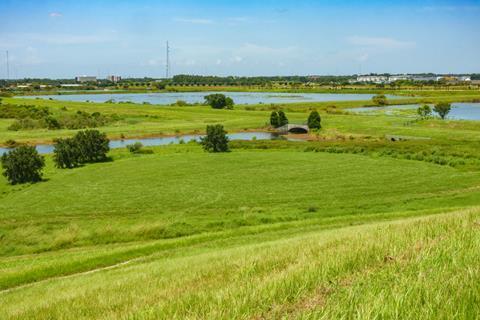With BNG on major developments made mandatory from this month, several local authorities are adopting policies that exceed the new requirement
More local authorities have been progressing planning policies that would require developers to deliver a greater level of biodiversity net gain than the 10% requirement.

Research by property consultancy Carter Jonas has found that three local planning authorities (LPAs) have adopted a biodiversity net gain (BNG) policy over 10%, while 17 (or 5.6%) have such a policy emerging through their local plan review.
This represents an increase of 33.3% compared with Carter Jonas’ Q4 data from 2022.
>> Also read: Why don’t we care more about preserving biodiversity
As of this month, under the Environment Act, a 10% BNG will become mandatory for most major developments, and for smaller sites by April 2024. Implementation for nationally significant infrastructure projects remains planned for 2025.
Last September, the government announced that the introduction of mandatory BNG would be pushed back from November to this month.
The research, which looks at data from 1 October to 31 December 2023, found that the majority of LPAs with BNG policies over 10% call for 20% net gain, either for some or all new developments.
Kingston upon Thames and Tower Hamlets have emerging policies which will require a minimum of 30% net gain.
The Carter Jonas research has reviewed the 306 LPAs in England to understand which local authorities have adopted a higher BNG percentage or are consulting on one. The research only includes policies that have been adopted or are in a draft local plan.
The authorities in Chelmsford and Birmingham, which are in the earlier stages of their local plan reviewand therefore excluded from the research, are also considering a higher level of net gain than the 10% requirement.
Carter Jonas concluded that policies requiring over 10% BNG are concentrated in the south of England:
- In the South-east, 11 LPAs have a BNG policy, either emerging or adopted, that demands a greater than 10% net gain. This accounts for 16.7% of LPAs in the region.
- The South-west and London both have three LPAs with a higher net gain policy, representing 10.3% and 9.1% of their LPAs, respectively.
- The East of England has two LPAs, accounting for 4.3% of the region’s LPAs, and Yorkshire and the Humber has one, which is 5.9% of the total LPAs in the region.
- In the North-west, North-east, West Midlands and East Midlands no LPAs make this requirement.
Sophie Davidson, associate in the research team at Carter Jonas, said: “Some regional variation can be attributed to the influence of Local Nature Partnerships (LNPs), which is evident in the South. For example, the Kent Nature Partnership is promoting a county-wide target of 20% within Kent and Medway. In response to this, Kent County Council (with funding support from Natural England) commissioned a strategic viability assessment of BNG in Kent.
“The report concludes that the biggest cost in most cases is to get to 10% net gain, and the increase to 15% or 20% is ‘generally negligible’. This has influenced emerging policies in Sevenoaks, Maidstone, Canterbury and Swale so far, representing 30.7% of the county.
“Likewise, the Surrey Nature Partnership and Sussex Local Nature Partnership have directed higher net gain targets in their counties.”
LNPs are partnerships of a broad range of local organisations, businesses and people who aim to help bring about improvements in their local natural environment.
Davidson added: “In areas with higher net gain requirements, we can expect the local market to develop at a faster rate. Many LPAs have stalled their local plan reviews in the face of significant changes to national planning policy, so BNG policies have taken longer to develop than expected.
“But, as changes are formalised and local plan reviews progress, expect to see more LPAs progressing higher levels of BNG. We are aware of several which have included an option to consider a greater scope for BNG in early consultations.”



























No comments yet